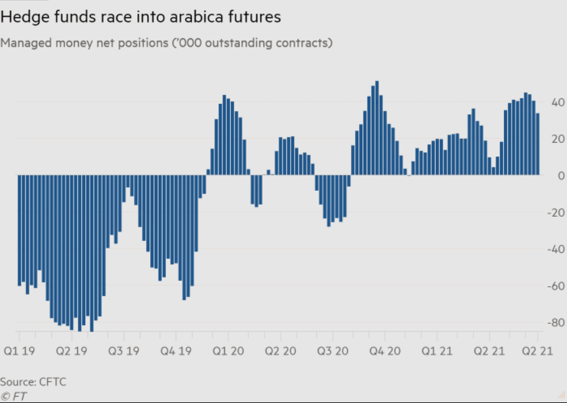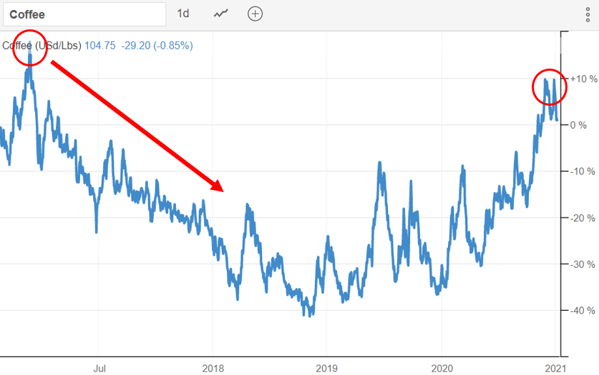Should consumers expect a surge in the retail price of coffee? Recent constraints and market players suggest otherwise, but for how long can they incur the cost? Tchibo already threw in the towel.
Key takeaways
- Arabica, top grade coffee beans, have seen futures contracts soar for green coffee beans (new beans).
- Hedge funds have been seen speculating on the rising price of coffee with inflows of funds nearing new yearly highs.
- The rise of coffee beans seems to be supply side constrained, with the added costs of shipping from the container shortage weighing down on the coffee market.
- 2016 saw a similar situation, mainly in that the drought we are seeing in Brazil, is not a new event, and that 2021 could already be seeing the end of the peak.
- Nestle's Nespresso division has decided not to raise prices on coffee products yet, while Germany's Tchibo has already implemented higher prices.
Why Coffee futures are soaring
As you may have noticed, certain regions of the world are experiencing natural disasters, disasters vast enough to make its way into the coffee futures markets. In Brazil, a terrible drought has led to a shortage of Brazilian production for 2021, a shortage of ''green coffee'', those beans buyers try to lock in ahead of time at predetermined prices.
However, there was a surge in production in 2020 not seen in years, so there is enough supply and inventories are there, according to Rabobank. The problem seems to be therefore more closely linked to the logistical maritime trade issues that have plagued other industries than an actual coffee shortage. There is for example, in Colombia, an export stall related to anti-government protests, but the coffee is there. Beyond protests, we know there are still maritime shipping bottlenecks in key trade hubs which have exporters hanging on to their inventories on home soil. The Colombian Coffee Growers Federation chief executive Roberto Velez has said that the unraveling of this hold up could take another two months.
Coffee prices rising has hence become a speculative asset in Q4 2020 and all of 2021, at least according to the graph below indicating rising net positions in arabica futures (arabica grains are the high quality coffee grains). According to the commodity futures trading commission, data shows that financial speculators, in early June, have accumulated a growing net long position equivalent to Colombia's production. This suggests hedge fund investors are bullish on prices rising, potentially because they don't see supply side constraints softening for some time.
Figure of net long positions on arabica futures contracts

What goes around comes around?
The prices we see today have reached a level previously encountered in July of 2016 when java junkies in the U.S. drove global coffee demand to record highs. Back then, there was a real demand side shift, with U.S. demand rising 1.5%, according to USDA forecasts. Cheaper gasoline prices put more Americans on the road for longer durations and as the rise of single cup to go coffee cold brew began to take off, so did prices.
Arabica-coffee futures traded in New York and jumped 20% in June 2016 as stockpiles at warehouses monitored by ICE dropped 11 straight quarters and global inventories dropped to four-year lows. At the same time, heavy rains in Brazil had hurt coffee plants. A drought, much like right now, had hit plantations hard and created a supply crunch which matched with a soaring demand from the U.S., China and Japan that year pull the futures northward.
The following figure shows a 2016 coffee price peak followed by a tumbling run of form in the next two consecutive years. We don't have a crystal ball, but it is entirely possible for a repeat trend considering the scenarios are, at the onset, very similar in form. It is unclear whether or not prices will stabilize at a new normal, but considering the supply side constraints could soon unravel, it is entirely possible for prices to fall--this is clearly Nestle's view considering their stagnant price policy.
Figure indicating the downward trend after a 2016 peak

How are coffee makers responding to climbing prices
Nespresso, Nestle's premium coffee division, said they won't be raising prices for their coffee capsules. So far, there is not enough clarity on the situation for there to be a big price change says Nespresso's chief executive. So far the firm has incurred the extra cost on their margins, margins that soared recently on what has been a record year for the Nespresso pod division which saw sales soar 17% in North America.
Tchibo, on the other hand, has already raised its prices in anticipation of further price upswings. Tchibo said in a statement that the green coffee they had to stock up on was quite expensive, especially the higher quality beans that they like to offer clients. Because they reach for only the most fresh and high grade beans, it makes sense to see them more inclined to pass on the extra cost to customers.
In vietnam coffee prices are seeing pressure related to rising shipping costs hindering transactions between parties in Hanoi. Farmers in the country's largest coffee-growing region have seen increased movement restrictions as of yesterday, that are expected to significantly slow down entire domestic transactions of coffee beans. In Ho Chi Minh city, a fresh 15 day movement restriction has put a pause to trade, but some analyst suggest the movement curbs won't have a long lasting impact on coffee export prices. Traders in Vietnam offered 5% black and broken-grade robusta at a discount of $60-$100 per tonne to the September contract compared with last week's smaller $50 discount.
Conclusions
The surge in prices could be posed for prolonged pressures, which is perhaps why Tchibo decided to raise prices now before seeing its bottomline continue going down its shrinking path. Large coffee players do come to mind; Nestle, Starbucks, and McDonald's, but what is tricky, is how to make sense of the supply side constraints explained above and their influence on share prices.
Be mindful that if prices continue to rise and Nestle continues to incur the costs on their books, their profit margins will shrink meaning earnings will fall hence shrinking their EPS and their share price on public markets. On the other hand, if the prices stabilize but the result is a falling demand because of a price now made higher, firms like Tchibo could bear the consequences.
Overall, supply constraints seem to be related to short term seasonal issues in bad weather, and the difficulty of moving inventory around. Green coffee is becoming more expensive, but there is no shortage of coffee on the planet. It's a logistical issue driving up prices, something that should not be mistakenly confused for inflation. Other commodities like sugar have recently seen a falling price after Brazil's frost has been rumoured to be over blown. Generally speaking, is the fed right about transitory inflation?





